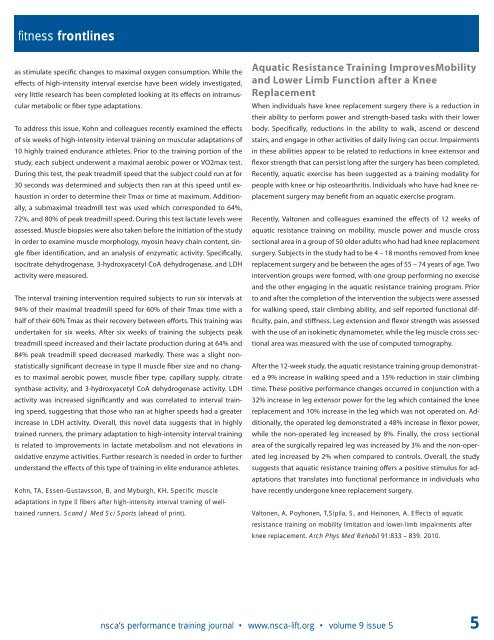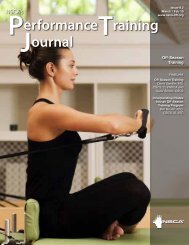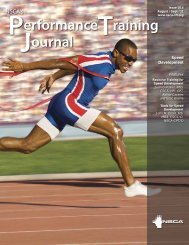PTJ Sep Oct 2010.pdf
PTJ Sep Oct 2010.pdf
PTJ Sep Oct 2010.pdf
You also want an ePaper? Increase the reach of your titles
YUMPU automatically turns print PDFs into web optimized ePapers that Google loves.
fi tness frontlines<br />
as stimulate specific changes to maximal oxygen consumption. While the<br />
effects of high-intensity interval exercise have been widely investigated,<br />
very little research has been completed looking at its effects on intramuscular<br />
metabolic or fiber type adaptations.<br />
To address this issue, Kohn and colleagues recently examined the effects<br />
of six weeks of high-intensity interval training on muscular adaptations of<br />
10 highly trained endurance athletes. Prior to the training portion of the<br />
study, each subject underwent a maximal aerobic power or VO2max test.<br />
During this test, the peak treadmill speed that the subject could run at for<br />
30 seconds was determined and subjects then ran at this speed until exhaustion<br />
in order to determine their Tmax or time at maximum. Additionally,<br />
a submaximal treadmill test was used which corresponded to 64%,<br />
72%, and 80% of peak treadmill speed. During this test lactate levels were<br />
assessed. Muscle biopsies were also taken before the initiation of the study<br />
in order to examine muscle morphology, myosin heavy chain content, single<br />
fiber identification, and an analysis of enzymatic activity. Specifically,<br />
isocitrate dehydrogenase, 3-hydroxyacetyl CoA dehydrogenase, and LDH<br />
activity were measured.<br />
The interval training intervention required subjects to run six intervals at<br />
94% of their maximal treadmill speed for 60% of their Tmax time with a<br />
half of their 60% Tmax as their recovery between efforts. This training was<br />
undertaken for six weeks. After six weeks of training the subjects peak<br />
treadmill speed increased and their lactate production during at 64% and<br />
84% peak treadmill speed decreased markedly. There was a slight nonstatistically<br />
significant decrease in type II muscle fiber size and no changes<br />
to maximal aerobic power, muscle fiber type, capillary supply, citrate<br />
synthase activity, and 3-hydroxyacetyl CoA dehydrogenase activity. LDH<br />
activity was increased significantly and was correlated to interval training<br />
speed, suggesting that those who ran at higher speeds had a greater<br />
increase in LDH activity. Overall, this novel data suggests that in highly<br />
trained runners, the primary adaptation to high-intensity interval training<br />
is related to improvements in lactate metabolism and not elevations in<br />
oxidative enzyme activities. Further research is needed in order to further<br />
understand the effects of this type of training in elite endurance athletes.<br />
Kohn, TA, Essen-Gustavsson, B, and Myburgh, KH. Specifi c muscle<br />
adaptations in type II fi bers after high-intensity interval training of welltrained<br />
runners. Scand J Med Sci Sports (ahead of print).<br />
Aquatic Resistance Training ImprovesMobility<br />
and Lower Limb Function after a Knee<br />
Replacement<br />
When individuals have knee replacement surgery there is a reduction in<br />
their ability to perform power and strength-based tasks with their lower<br />
body. Specifically, reductions in the ability to walk, ascend or descend<br />
stairs, and engage in other activities of daily living can occur. Impairments<br />
in these abilities appear to be related to reductions in knee extensor and<br />
flexor strength that can persist long after the surgery has been completed.<br />
Recently, aquatic exercise has been suggested as a training modality for<br />
people with knee or hip osteoarthritis. Individuals who have had knee replacement<br />
surgery may benefit from an aquatic exercise program.<br />
Recently, Valtonen and colleagues examined the effects of 12 weeks of<br />
aquatic resistance training on mobility, muscle power and muscle cross<br />
sectional area in a group of 50 older adults who had had knee replacement<br />
surgery. Subjects in the study had to be 4 – 18 months removed from knee<br />
replacement surgery and be between the ages of 55 – 74 years of age. Two<br />
intervention groups were formed, with one group performing no exercise<br />
and the other engaging in the aquatic resistance training program. Prior<br />
to and after the completion of the intervention the subjects were assessed<br />
for walking speed, stair climbing ability, and self reported functional difficulty,<br />
pain, and stiffness. Leg extension and flexor strength was assessed<br />
with the use of an isokinetic dynamometer, while the leg muscle cross sectional<br />
area was measured with the use of computed tomography.<br />
After the 12-week study, the aquatic resistance training group demonstrated<br />
a 9% increase in walking speed and a 15% reduction in stair climbing<br />
time. These positive performance changes occurred in conjunction with a<br />
32% increase in leg extensor power for the leg which contained the knee<br />
replacement and 10% increase in the leg which was not operated on. Additionally,<br />
the operated leg demonstrated a 48% increase in flexor power,<br />
while the non-operated leg increased by 8%. Finally, the cross sectional<br />
area of the surgically repaired leg was increased by 3% and the non-operated<br />
leg increased by 2% when compared to controls. Overall, the study<br />
suggests that aquatic resistance training offers a positive stimulus for adaptations<br />
that translates into functional performance in individuals who<br />
have recently undergone knee replacement surgery.<br />
Valtonen, A, Poyhonen, T,Sipila, S, and Heinonen, A. Effects of aquatic<br />
resistance training on mobility limitation and lower-limb impairments after<br />
knee replacement. Arch Phys Med Rehabil 91:833 – 839. 2010.<br />
nsca’s performance training journal • www.nsca-lift.org • volume 9 issue 5 5





